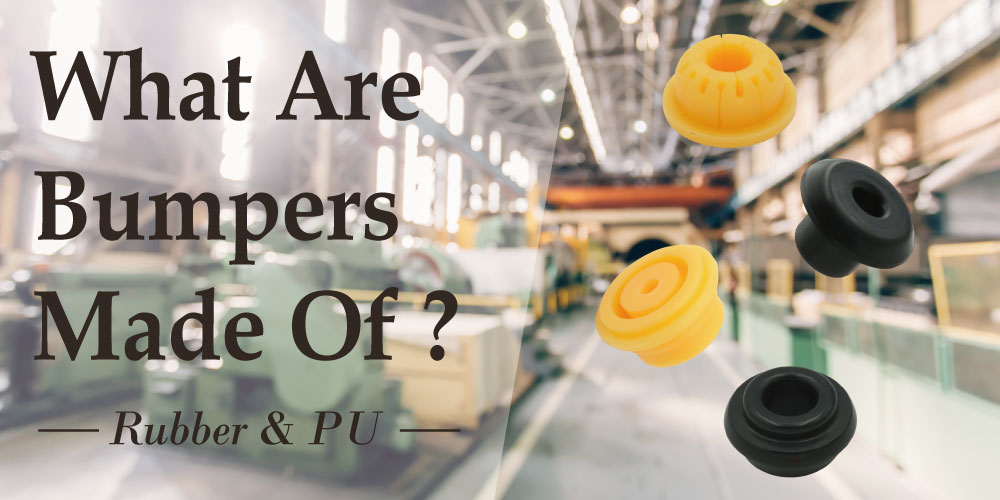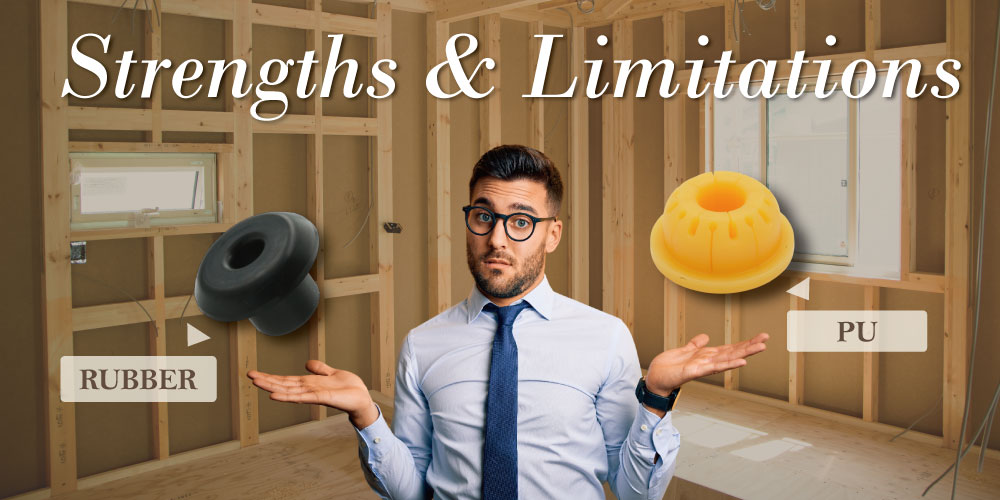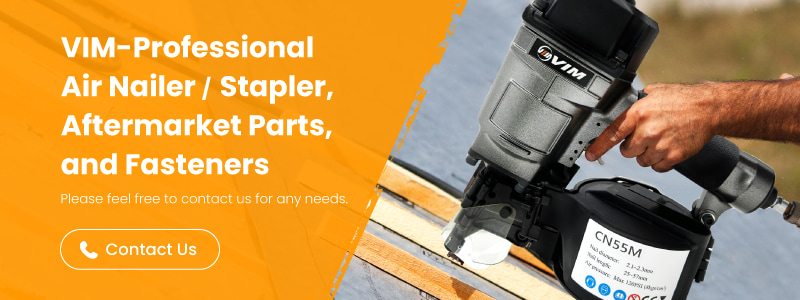- Home
- INSIGHT
- Spare Parts
- The 2 Leading Nail Gun Bumper Materials You Don’t Want to Overlook
The 2 Leading Nail Gun Bumper Materials You Don’t Want to Overlook

Selecting the right aftermarket bumper for your nailers and staplers goes far beyond choosing the correct size or fit. One often overlooked—but highly influential—factor is the bumper material. Although all nail gun bumpers serve the same core function of absorbing impact and protecting internal components, their performance, durability, and cost-effectiveness can vary greatly depending on whether they are made of rubber or polyurethane (PU).
In this article, we break down the key differences between rubber bumpers and PU bumpers, including their strengths, limitations, ideal usage scenarios, and how material choice affects firing consistency, tool lifespan, user comfort, and long-term maintenance cost. We’ll also introduce VIM’s latest aftermarket bumper lineup to help you match the right material to the right job.
What Are Nail Gun Bumpers Made Of?
 When it comes to choosing a reliable aftermarket bumper for your pneumatic tools, the material matters just as much as the fit. While nail gun bumpers may look similar at first glance, the performance and lifespan can vary significantly depending on the material used. Today, the two dominant materials found in both OEM and aftermarket bumper replacements are Rubber and Polyurethane (PU).
When it comes to choosing a reliable aftermarket bumper for your pneumatic tools, the material matters just as much as the fit. While nail gun bumpers may look similar at first glance, the performance and lifespan can vary significantly depending on the material used. Today, the two dominant materials found in both OEM and aftermarket bumper replacements are Rubber and Polyurethane (PU).
Why Rubber and PU Lead the Market
These two materials—used to produce rubber bumpers and PU bumpers—have become the industry standard because they offer the best balance of shock absorption, durability, and cost-efficiency. Each material brings a unique performance profile to the nail gun bumper, making them suitable for different jobsite conditions and firing frequencies:
Rubber Bumpers
Known for their flexibility and soft impact cushioning, rubber bumpers are commonly used for general-duty applications. They deliver smooth shock absorption and are economically priced, making them a popular choice in repair shops and standard tool maintenance.
Polyurethane (PU) Bumpers
PU bumpers are engineered for tougher, high-cycle environments where durability and rebound control are crucial. Polyurethane offers better wear resistance, greater elasticity retention, and a longer service life—ideal for professionals who rely on consistent tool performance with reduced downtime.
【Extended reading: What is Driver Blade? Accomplished knowledge in original vs. aftermarket! 】
Rubber vs PU Nail Gun Bumpers: Strengths & Limitations
 When selecting an aftermarket bumper, understanding the material differences between a rubber bumper and a PU bumper is key to ensuring the best performance and service lifespan for your air nailer. Both materials serve the same fundamental purpose—absorbing impact and protecting internal components—but they behave very differently under real jobsite conditions.
When selecting an aftermarket bumper, understanding the material differences between a rubber bumper and a PU bumper is key to ensuring the best performance and service lifespan for your air nailer. Both materials serve the same fundamental purpose—absorbing impact and protecting internal components—but they behave very differently under real jobsite conditions.
Rubber
Rubber is the more traditional material used for nail gun bumper manufacturing. It is known for its natural flexibility, soft cushioning, and stable shock absorption, especially for standard-duty applications
Advantages
- Excellent shock absorption for smooth, comfortable operation.
- Cost-effective and widely available among aftermarket bumper options.
- Performs well in moderate temperatures and general-use environments.
Limitations
- More prone to hardening, cracking, or deforming under continuous high-impact firing.
- Shorter overall lifespan compared to PU—particularly for high-frequency or industrial use.
Rubber bumpers are ideal for general-duty and everyday-use nailers, DIY owners, and repair centers handling standard maintenance and tool servicing, where comfort and cost-efficiency are key priorities.
PU
Polyurethane (PU) is a more advanced and durable material that offers higher density, improved elasticity, and better resistance to abrasion, heat, and repeated impact—making PU bumpers well-suited for professional and industrial environments.
Advantages
- Superior durability and longer service life for high-cycle applications.
- Retains elasticity and shape under continuous impact and elevated temperatures.
- Better rebound control for quicker piston reset and more consistent firing performance.
Limitations
- Slightly higher cost than rubber aftermarket bumpers.
- Shorter storage lifespan (about 3 years) compared with rubber bumpers.
PU bumpers are ideal for professional and high-cycle nailer users, contractors, and repair centers supporting intensive tool operation, where durability, consistent performance, and reduced maintenance frequency are key priorities. Best for factories where tools are used in continuous or 24/7 high-cycle production.
Comparison Table
| Category | Rubber Bumper | PU Bumper |
|---|---|---|
| Material Profile | Traditional material Natural flexibility and soft cushioning |
Advanced, high-density material Enhanced elasticity and impact resistance |
| Shock Absorption |
Softer Smoother cushioning for comfortable operation |
Firmer rebound Better control for consistent piston reset |
| Durability in Use |
Shorter lifespan under continuous high-impact or high-frequency firing | Superior durability and longer service life for high-cycle applications, including continuous-use tools |
| Temperature Performance |
Performs well in moderate, everyday environments | Retains elasticity under heat and repeated impact; may stiffen in sub-zero temperatures (below -10°C / 14°F) |
| Shelf Life (Storage) | Long storage lifespan (typically 8–10 years when stored properly) |
Shorter storage lifespan (approx. 3 years) |
| Cost | More cost-effective and widely available among aftermarket bumper options | Slightly higher cost than rubber aftermarket bumpers |
| Ideal Users / Applications | . General-duty and everyday-use nailers . DIY owners . Repair centers handling standard maintenance . Prioritizing comfort and cost-efficiency |
. Professional and high-cycle nailer users . Contractors . Repair centers supporting intensive tool operation . 24/7 production environments where durability and performance consistency are key priorities |
【Extended reading: Beyond OEM: 6 Reasons Why More Distributors Are Switching to Aftermarket Bumpers】
How Material Choice Impacts Air Nailer Performance
 The material used in a nail gun bumper plays a direct role in how efficiently and comfortably a nailers and staplers perform. Choosing the right aftermarket bumper—whether a rubber bumper or PU bumper—can influence recoil, firing behavior, internal wear, and the long-term cost of tool ownership. Here’s how material choice makes a measurable difference:
The material used in a nail gun bumper plays a direct role in how efficiently and comfortably a nailers and staplers perform. Choosing the right aftermarket bumper—whether a rubber bumper or PU bumper—can influence recoil, firing behavior, internal wear, and the long-term cost of tool ownership. Here’s how material choice makes a measurable difference:
Recoil Reduction & User Fatigue
A bumper’s ability to absorb and cushion impact affects how much recoil transfers to the user.
- A softer rubber bumper provides gentler impact absorption, reducing hand strain during standard-duty work.
- A PU bumper, with firmer rebound control, minimizes excessive vibration during high-cycle operation, helping maintain comfort over long shifts.
The right bumper material helps reduce operator fatigue, especially for professionals using the tool for extended hours.
Piston Reset Speed & Firing Consistency
After each shot, the bumper influences how quickly and smoothly the piston returns to its starting position.
- Rubber offers a softer rebound, suitable for steady everyday firing speeds.
- PU provides a quicker and more controlled piston reset, supporting faster, more consistent firing cycles—ideal for production lines or rapid-fire applications.
In short, PU enhances firing rhythm and consistency when speed and precision are required.
Internal Wear & Tool Lifespan
A high-quality aftermarket bumper helps prevent direct metal-to-metal contact inside the tool. Material performance affects internal protection:
- Rubber cushions impact well but may compress or deform over time, increasing internal stress under heavy use.
- PU maintains its shape under repeated force, providing more stable protection for the cylinder, driver, and piston assembly during high-frequency or industrial use.
Better impact control means less internal wear and a longer overall tool lifespan.
Maintenance Frequency & Long-Term Ownership Cost
Material durability also influences how often the bumper must be replaced.
- Rubber is cost-effective but requires more frequent replacement in intensive applications.
- PU lasts longer in active use, reducing downtime and part replacement intervals.
For users who run tools occasionally, rubber offers an economical solution. For high-cycle or 24/7 use, PU often results in a lower long-term cost of ownership despite a slightly higher upfront price.
【Extended reading: Maximize Tool Performance: 4 Smart Ways to Pick the Best Air Tool Fittings】
【Extended reading: 6 Truths About Aftermarket Air Stapler Parts and Air Nailer Parts】
NEW: VIM’s Latest Aftermarket Bumper Lineup (PU & Rubber)
 To meet different usage intensities and tool maintenance needs, VIM introduces an updated range of aftermarket bumper options in both rubber and PU bumper materials. Each model is engineered for proper fit, stable impact absorption, and reliable protection for your pneumatic fastening tools.
To meet different usage intensities and tool maintenance needs, VIM introduces an updated range of aftermarket bumper options in both rubber and PU bumper materials. Each model is engineered for proper fit, stable impact absorption, and reliable protection for your pneumatic fastening tools.
Rubber Series – Cost-Effective & Reliable for Standard Duty
Models & Compatibility:
- 404419 — Paslode 900420 / 902200 CF325 (Cordless Framing Nailers — Battery Powered)
- 404419 — Paslode 902600 (Powder-Actuated Nailer)
Key Highlights:
- Smooth impact cushioning for everyday fastening needs
- Ideal for general-duty servicing and regular on-site use
- A practical and economical choice for repair centers and light-to-medium duty nailer maintenance
This rubber bumper is suitable for users prioritizing comfort and cost-efficiency when maintaining standard-use nail gun models.
PU Series – Enhanced Durability for High-Cycle Use
Models & Compatibility:
- 500866 — Paslode F350S, F350, PF350S, F325R, F250S-PP, F400S (Framing Nailers)
- 878-179 — Hitachi NV45AB2 (Coil Roofing Nailer)
- 878-303 — Hitachi NR83 / NR83A / NR83A2 (Framing Nailers)
Key Highlights:
- Longer service life under continuous or high-frequency firing
- More stable rebound to support consistent firing rhythm in demanding applications
- Designed for professional contractors and 24/7 jobsite or production-line environments
These PU bumpers are built for durability and performance stability, making them ideal for high-cycle framing or roofing nailers that require lower downtime and reduced maintenance frequency.
【Extended reading: What Happens When a Driver Blade Fails? Lessons from the Paslode 901078】
【Extended reading: Need Spare Parts for Paslode Nailers? High Quality Alternatives by VIM】
Conclusion
Selecting the right nail gun bumper is more than a routine replacement—it directly influences tool comfort, firing consistency, internal wear, and long-term maintenance cost. Rubber bumpers remain a practical, cost-efficient choice for general-duty nailers, offering smooth shock absorption for everyday work. Meanwhile, PU bumpers provide increased durability and performance stability for high-cycle, professional, or 24/7 production environments where reduced downtime and longer service life make a measurable difference. Choosing the right material ultimately comes down to how intensively your tools are used and what level of performance you aim to achieve.
If you’re looking for aftermarket bumper solutions with reliable fit, proven performance, and long-term supply support, VIM is ready to assist. Our bumper range includes both rubber and PU options, engineered for real-world durability and covering a wide variety of models across multiple brands—not just Paslode and Hitachi. If you are considering whether upgrading from rubber to PU would benefit your tools or working conditions, we can help assess the most suitable choice based on your usage requirements.
Contact VIM for specifications, pricing, samples, or distributor support—and keep your tool fleet running at its best.
Article Classification
Recent Articles
- The 2 Leading Nail Gun Bumper Materials You Don’t Want to Overlook
- Maximize Tool Performance: 4 Smart Ways to Pick the Best Air Tool Fittings
- What Happens When a Driver Blade Fails? Lessons from the Paslode 901078
- Nail Gun Leaking Air from Trigger? Step-by-Step Fix & Prevention
- What Technicians Don’t Tell You: 6 Moves to Fixing Driver Units and Restoring Nailers

